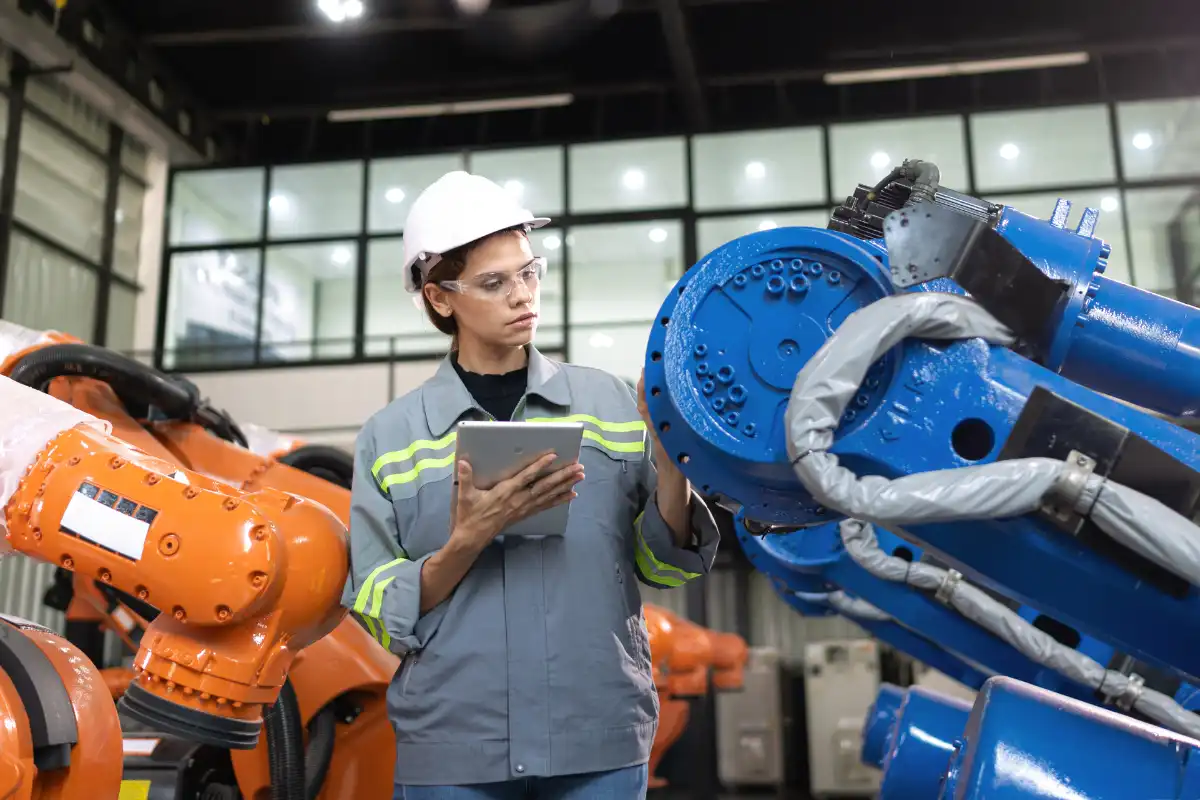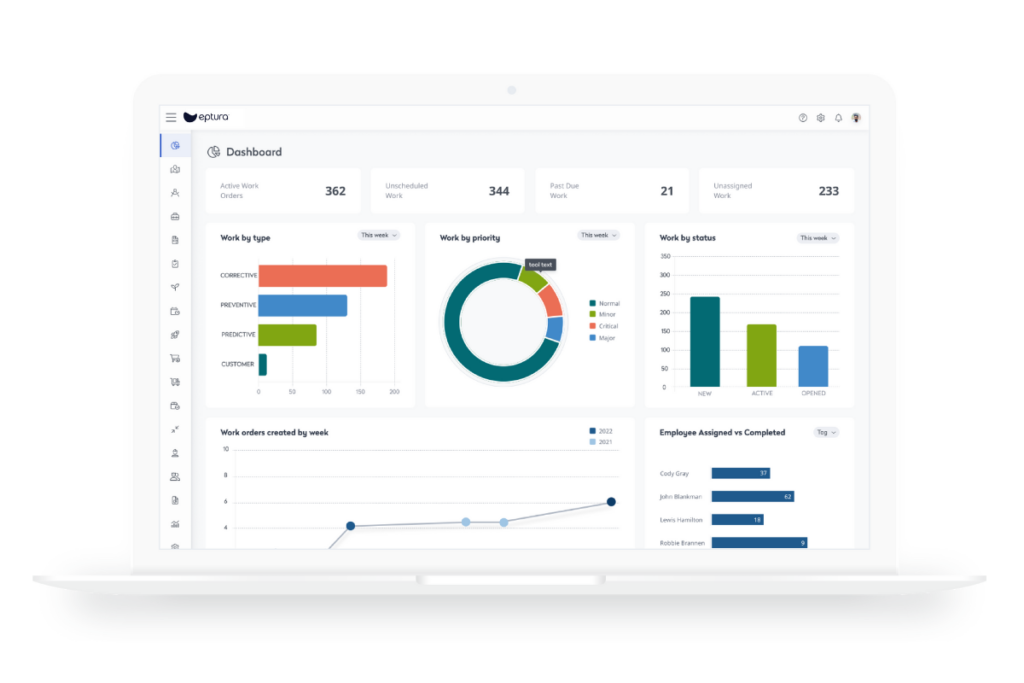
Modern maintenance management is all about working with large data sets. Often, it’s to track key performance indicators, but increasingly to use predictive maintenance (PdM), where, for example, you feed an asset’s digital twin a steady stream of real-time data so it can warn you about future failures long before they happen.
And that’s just the start of the endless applications of artificial intelligence (AI) in maintenance.
What is artificial intelligence (AI)?
Before looking at its future in maintenance, it’s important to have a solid sense of what AI is and where it’s heading.
A basic definition of AI is that it’s an intelligent entity created by humans that can perform tasks without explicit instructions. Also, it can think and act rationally and humanly. Because of how often humans are irrational and sometimes biased, it’s possible to define AI as the best possible version of ourselves. But that’s a bit philosophical.
Back down at a more practical level, a good way to understand AI is to look at some of the common ways researchers divide it into different types.
Strong and weak AI
So, you can classify AI as strong or weak. Strong AI has a wider scope, human-level intelligence, and can cluster and associate data. Weak AI has a relatively narrower scope, is only good at specific tasks, and can use a combination of supervised and unsupervised learning to process data. A good example of weak AI is a simple computer chess game.
Artificial narrow intelligence (ANI), artificial general intelligence (AGI), and artificial super intelligence (ASI)
ANI is currently the most common and most established type of AI application. It’s able to do one task well, but only that one task. An example could be an AI that can guess what products you might also be interested in by looking at past purchases. Another would be an AI that can predict the weather.
For facility and maintenance managers, an ANI would be able to predict future occupancy rates by looking at historical data or tell you the best time to change out the air filters on a piece of equipment based on sensor data fed into a digital twin. Another example is an AI that can make data-back suggestions for space planning and help employees reserve desks that best fit their work goals, including positioning team members close together to support connection and collaboration on in-office days.
AGI is growing in research and implementation. Instead of being good at one task, an AGI would excel at a range of competencies, including:
- Language processing
- Image processing
- Computational functioning
- Reasoning
Basically, it has similar capabilities to a regular person, able to pay attention to a conversation while driving a car and trying, in the back of their head, to estimate how much longer the ride is going to take based on the amount of traffic.
The future of AI in maintenance
The future applications of AI in maintenance likely lay in the technology’s two main abilities: distilling large data sets into discrete actionable insights and creating natural-sounding language from simple prompts.
Basically, maintenance teams are going to use AI to make big numbers smaller, more digestible, and short phrases into longer, easier-to-understand instructions and follow-ups.
It can also enhance building energy efficiency by optimizing energy profiles and predicting maintenance needs, allowing for proactive measures. By integrating AI with digital twins and building information models (BIM), businesses can achieve a unified data view, enabling predictive analytics that anticipate issues before they occur, thus improving overall operational efficiency and sustainability.
Deloitte’s 2023 report on using AI in predictive maintenance to forecast the future dives deep into the potential for machine learning to surpass outdated, inefficient predictive maintenance methods, outlining enterprises’ current need to integrate AI to save time, money, and boost return on investment.
“Historically, maintenance schedules may have been either based around estimates of a machine’s lifetime and projected time to failure or based on recommendations from the original equipment manufacturer. To help improve maintenance operations, the enterprise can replace educated guesses with data-based knowledge about how an asset is performing and when it will degrade.
Getting to this level of predictive maintenance begins with incorporating additional data sources.”
Using sensors as an example of a kind of data source, they further explain that “When the data is consolidated and interpreted with AI-enabled signal processing, the result can be a deeper and more nuanced understanding of not just individual machines but the larger network of interdependent assets. By harnessing the collective knowledge of people, sensors, and systems, the business can use AI to analyze the information and output maintenance recommendations.”
Essentially, a future-forward maintenance team would be compiled of managers, employees, and an omnipresent AI-backed maintenance solution to help the human workforce make better decisions.
Predictive maintenance and AI
Like with many terms, the definition of PdM depends on who you ask. It also depends on when you ask because the technology is quickly evolving. But a broad definition would include the fact that PdM leverages both historical and real-time data from assets and equipment to warn you of future failures so you can find and fix small issues before they have a chance to create costly downtime.
PdM involves a lot of data from many different sources. According to a report on using machine learning in manufacturing, “ML algorithms are fed OT data (from the production floor: sensors, PLCs, historians, SCADA), IT data (contextual data: ERP, quality, MES, etc.), and manufacturing process information describing the synchronicity between the machines, and the rate of production flow.”

But what’s the role of AI?
PdM is like a fortune teller for your assets, where the crystal ball is all the data, and the AI is the person peering into it. Once you train the AI on what the data from the assets should look like, the software can find trends and then anomalies.
If you removed the AI from the process, you’d have something closer to condition-based maintenance, where the software warns you as soon as the asset moves outside of what you told it are the acceptable operational ranges. You don’t even need fancy software for that, though. A simple physical thermostat with two metals bent into one coil can tell you when things are getting too hot inside an engine, for example.
Current and future use cases for AI in maintenance
Outside of predictive maintenance, where AI works with large data sets from sensors and digital twins to tell you the best times and tasks for maintenance, the future of AI in maintenance will likely leverage the new technology’s capacity to generate natural-sounding language.
Boosting building energy efficiency
Integrated digital solutions play a crucial role in enhancing building energy efficiency. In fact, AI-based management systems can improve the energy efficiency of buildings by 30%. By centralizing data, businesses can comprehensively understand their building’s performance and utilization. This enables leaders to optimize energy profiles by adjusting space usage, such as taking floors or zones offline when not needed, to save energy. Additionally, preventive and predictive maintenance facilitated by integrated solutions ensures that facility assets operate efficiently, reducing energy consumption and allowing for timely replacement with more sustainable options.
The integration of AI and BIM data into digital twins further enhances energy efficiency by creating a learning ecosystem that continuously improves energy use and reduces emissions. It’s now possible to optimize your maintenance operations and identify strategic capital improvements with your asset information on one platform with Eptura AI.
Predictive analytics
Predictive analytics, powered by AI, transforms maintenance strategies from reactive to proactive. By capturing real-time data from assets and utilizing digital twins, businesses can anticipate maintenance needs before issues arise, minimizing downtime and extending asset life. This approach not only increases operational efficiency but also reduces costs associated with unexpected repairs and replacements. Predictive analytics allows for better inventory management by forecasting when parts will need replacement for cost-effective ordering.
Improving communication with AI writing assistants
Most maintenance managers are looking for technicians who can read instructions, follow diagrams, and work their way through checklists. But those skills don’t directly translate into being able to write instructions, sketch out diagrams, and create checklists. They’re separate skill sets.
The result is that it’s generally easy to get information into your techs’ heads but more difficult to get it out. Work orders go out with clear instructions and neat lists of associated parts and materials, but the follow-up messages and close-out notes might come back riddled with typos, spelling mistakes, and unclear sentences.
With what’s being marketed as “generative AI,” everyone in the maintenance department gets a real-time communication assistant that helps them with everything from spelling and clarity to tone and style. Your tech can use prompts to explain to the AI the message they need to send. Because the AI already knows the department’s preferred tone and style, it can make a good first draft, which the tech can then fine-tune.
Or, when the tech writes the first draft themselves, the AI can check it for them, offering corrections for problems with spelling and grammar as well as suggestions on tone and style, including word choice and sentence structure.
The future of AI in maintenance is now
AI for maintenance practices is not just a technological advancement. It’s a strategic shift toward more efficient, cost-effective, and sustainable operations.
By harnessing the power of predictive maintenance, AI enables businesses to anticipate equipment failures before they occur, minimizing downtime and extending the useful lives of critical assets. This proactive approach marks a significant departure from traditional reactive maintenance strategies, offering substantial savings in both time and resources. And by integrating with digital twins and building information models, AI creates a dynamic ecosystem that continuously learns and adapts, optimizing energy usage and reducing emissions, delivering smarter energy management systems that can adjust energy profiles in real time. It also improves communication within maintenance teams. Even simple AI writing assistants help in crafting clear, concise, and effective communication, which is crucial for the successful execution of maintenance tasks.
In embracing AI, businesses are not only improving their current maintenance practices but are also paving the way for a more sustainable and efficient future.








